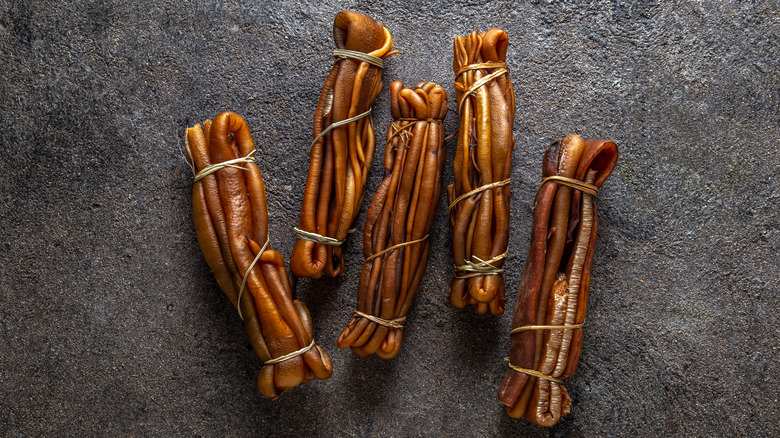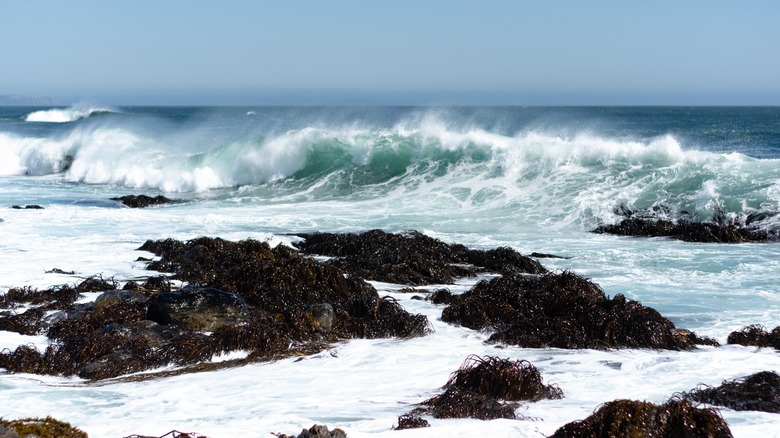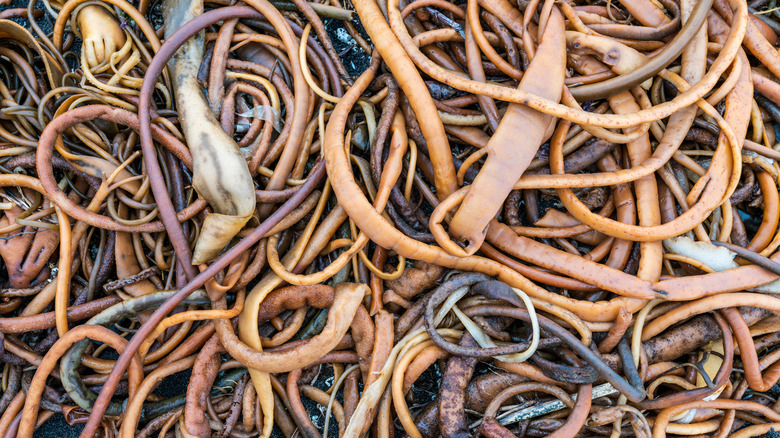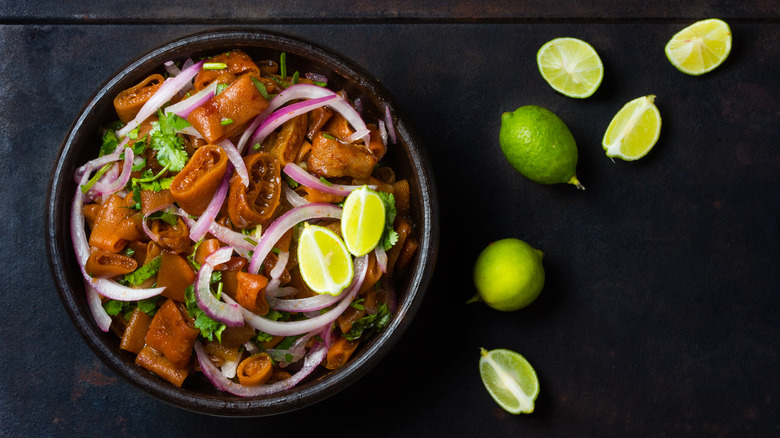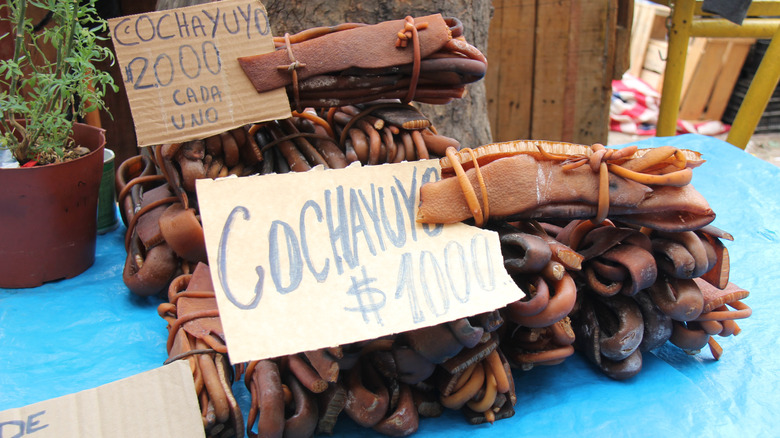Cochayuyo: The Delectable Sea Vegetable That's A Chilean Staple
Cochayuyo, scientifically called Durvillaea antartica, is a species of bull kelp that belongs to a food group known as blue foods (via Eating Chile). According to Blue Food Assessment, blue foods encompass "food derived from aquatic animals, plants, or algae that are caught or cultivated in freshwater and marine environments." As the dominant seaweed species in Chile, dried cochayuyo has been found within the hearths inside of Monte Verde — suggesting that the sea vegetable has been a Chilean food staple for more than 14,000 years, per Atlas Obscura.
Archeological findings also show that the Indigenous community in south-central Chile depended heavily on the protein-dense plant at the time when Spaniards first arrived in the South American country. Then called "collofe," "cochayuyo" literally translates from Quechan to "lake algae," according to Fondazione Slow Food.
Unfortunately, as with many other traditional Quechean foods — namely Peruvian chocho (per Mikuna Foods) — cochayuyo has a negative social connotation that's commonly associated with poverty. But the tides are turning. As conversations open up about the importance of sea vegetables, many scientists and experts, including the United Nations, believe that cochayuyo and other blue foods could be the foundation of a stable food system in the face of climate change.
How it's made
According to Atlas Obscura, cochayuyo grows wildly along the coastlines of New Zealand and Chile — predominantly in a southern area called Puerto Montt in the Lake Region. However, thanks to a distinctive honeycombed tissue, cochayuyo is unique to any other seaweed in its buoyancy. Its ability to float is beneficial because of its habitat of open sea waves and rocky coasts. Lookswise, cochayuyo ranges in color from brown to green and can grow up to 50 feet in length, resembling a long rope (via Fondazione Slow Food). Once harvested, the seaweed is typically left to dry in the sun before being sold in batches.
But even though cochayuyo is the most abundant species of seaweed found in Chile (via SBS), there isn't an indefinite supply of it. The Chilean government has proved itself to be a leading example of sustainable seaweed farming — a practice that removes carbon from the atmosphere, absorbs ocean pollutants, and supports wild fish stocks, per UC Chile. In fact, they passed a law that compensates small seaweed collectors who re-plant natural seaweed beds after harvest. There are also organizations like Huiro Regenerativo that work with the Indigenous people to combine sustainable cultivation methods with local knowledge and connect the community with the aquaculture industry.
Nutrition and benefits
Like other types of seaweed, cochayuyo is rich in protein, nutrients, and minerals like magnesium, iron, and iodine (per Fondazione Slow Food). Much of cochayuyo's impressive nutrition profile can be attributed to the simple fact that it grows in the ocean, one the best source of minerals on the planet — inevitably, however, it's also the source of the bull kelp's sodium content. Nevertheless, Eating Chile notes that cochayuyo is relatively fat-free and does not have a lot of calories.
The wide range and sheer amount of nutrients that cochayuyo and other blues foods provide are a major reason why they're so important to the United Nations Sustainable Development Goals. Not only is there an opportunity to reduce social inequalities and restore the oceans (via Blue Food Assessment), but building a stable food chain around sustainable aquaculture could make food insecurity a thing of the past. In fact, farming just 2% of the ocean could feed 12 billion people, according to the United Nations. That's well over the projected global population of 9 billion by the year 2050.
Cooking with cochayuyo
Flavorwise, cochayuyo is described as mildly salty and slightly smoky (via Eating Chile). According to Atlas Obscura, the bull kelp works well as a flavor enhancer — almost like a "natural form of MSG," a popular seasoning that combines umami and sodium, per The Washington Post. But, because the seaweed typically comes dried, it needs to be rehydrated in water before it's prepared — a process that can take anywhere from 20 minutes to hours, depending on the soaking method you choose. Although it is both safe and delicious to consume dried as a snack or seasoning.
After soaking, the fronds will be soft enough to scrape out, cut into small pieces, and then sauté, simmer, or serve fresh. Its mild flavor lends itself well to a variety of dishes. In Chile, for example, cochayuyo is used everywhere — from salads to ceviches to stews. When cooked, the plant's unique honeycombed tissue gives it a chewy texture that makes it a great meat substitute. For this reason, you can find chefs using the seaweed as a meat replacement to create vegetarian empanadas, croquettes, risottos, and more. It is also commonly used as a thickener in sauces.
Where to buy it
Unlike shopping in Chile, finding cochayuyo at your go-to grocery store or farmers market may not be possible — at least for now. Even though many species of seaweeds like spirulina have gained momentum in the US for their "superfood" status, the majority of ocean veggies are still integrating their way into western cuisine. So for now, you're more likely to find cochayuyo through an online retailer than you are in store.
A quick Google search will show a number of sites that sell different brands of cochayuyo. Amazon, for example, carries a brand called Amarea that sells fun-flavored cochayuyo snacks. On the other hand, Amigo Foods, the online Latin American food retailer, sells packages of dried chuchayuyo if you're interested in experimenting and cooking with them at home. However, if you do have the opportunity to visit Chile in the future, be sure to experience cochayuyo the way the locals do.
